Selecting the Right Self-Drilling Anchor Bolt Drill Bit for Different Ground Conditions
Time:2025-11-26From:sinorock View:
In geotechnical and tunneling projects, self-drilling anchor (SDA) bolts have become indispensable for stabilizing weak, fractured, or unpredictable formations. Their “drill-and-grout-in-one” mechanism eliminates the need for pre-drilling, reducing construction risks, shortening project timelines, and improving overall site safety. Yet the performance of an SDA system depends heavily on a component that is often overlooked—the drill bit.
Choosing the correct SDA drill bit is not merely a technical formality; it directly affects drilling efficiency, hole stability, grout penetration, tool life, and overall project cost. The wrong bit can slow penetration, accelerate wear, compromise grout quality, or even cause borehole collapse. Conversely, a well-selected bit ensures clean cutting, smooth rod guidance, effective grout delivery, and predictable drilling performance across varying formations.
This guide provides a complete and practical overview of how to select the right SDA drill bit for different formations encountered in mining, tunneling, slope stabilization, and foundation reinforcement.

1. Common Self-Drilling Anchor Bolt Drill Bit Types
Understanding the characteristics of each bit type is the first step in proper selection. The right bit balances penetration speed, wear resistance, impact toughness, and cost-effectiveness. Below is a detailed overview.
1.1 Clay Bit
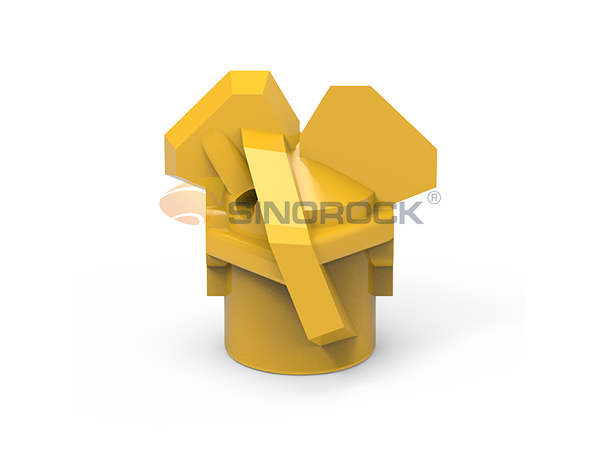
Design: A simple fish-tail or flat-blade profile with large flushing ports.
Pros: Rapid drilling in soft soils; simple construction; cost-effective.
Cons: Poor abrasion and impact resistance; easily damaged when hitting hard inclusions or debris.
Best For: Soft, non-abrasive materials such as clay, silt, and loose fill.
Additional Notes: Ideal in environmental applications where minimal disturbance is desired. The wide flushing ports reduce clogging, helping maintain hole stability. Regular inspection is recommended to prevent blade wear or deformation.
1.2 Cross-cut Bits
.jpg)
Cross-cut Drill Bit With Carbide
Features brazed carbide inserts forming a cross-shaped cutting head.
Pros: Excellent abrasion resistance; good impact strength; stable centering in boreholes.
Best For: Soft rock, weathered rock, and medium-hard rock.
Applications: Commonly used in tunneling and slope stabilization where formations are inconsistent. Carbide inserts allow the bit to fracture small boulders or cobbles without stopping for manual clearance.
Steel Cross-cut Drill bit
Made entirely from alloy steel without carbide.
Pros: Low manufacturing cost; easy to maintain.
Cons: Limited wear resistance; only suitable for very soft soils.
Applications: Often used for short-term projects or experimental drilling in non-abrasive strata.
1.3 Button Bits
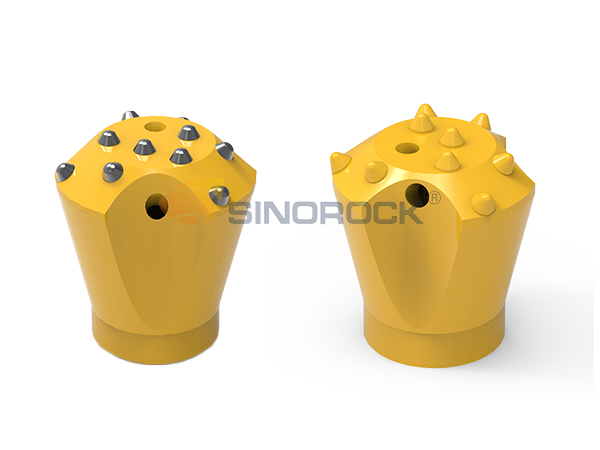
Carbide Button Bit
The head is embedded with multiple hemispherical or conical carbide buttons, crushing rock through impact.
Pros: High impact toughness; superior abrasion resistance; efficient for hard, abrasive rock.
Best For: Granite, basalt, quartzite, and other extremely hard formations.
Applications: Common in mining, quarrying, and high-strength tunneling projects. Button arrangement and spacing are critical for optimizing penetration rates and reducing tool wear.
Steel Button Bit
Similar to all-steel cross bits, performance is limited and not recommended for rock applications.
1.4 Specialty Bit Shapes
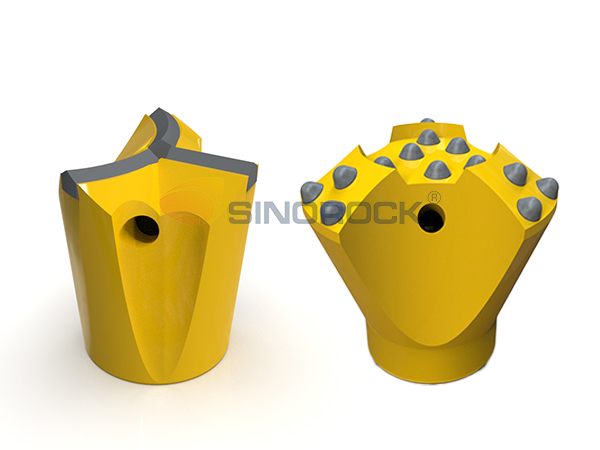
Arc-shaped Drill Bit
Arc-shaped Drill Bit improve guidance and cuttings removal.
Best For: Soft to moderately firm soils; ideal for projects requiring precise hole alignment.
Notes: Can be used with carbide inserts or alloy steel depending on soil hardness. The arc wings reduce side friction and improve hole straightness.
Concave Center Drill Bit
Features a recessed center to improve cuttings removal and reduce regrinding.
Best For: Very hard, abrasive rock formations.
Notes: Particularly useful in deep boreholes where debris accumulation can significantly slow penetration. Enhances cooling and reduces center-point overheating.
2. Selecting SDA Drill Bits for Different Formations
Different ground conditions present unique challenges. Selecting the correct bit ensures safety, efficiency, and cost-effectiveness.
2.1 Soft Soil Formations
Examples: Clay, silt, fill.
Challenges: Bit balling, poor cuttings removal, risk of borehole collapse.
Recommended: Clay Bit or Three-Wing Arc Bit.
Why: Smooth contours and large flushing ports prevent clogging, allow fast drilling, and reduce operational cost. Ideal for environmental and foundation projects where minimal disturbance is required.
2.2 Loose or Broken Ground
Examples: Sand, gravel, fill layers.
Challenges: Highly unstable hole walls; abrasive; cobble obstruction.
Recommended: Cross Carbide Bit.
Why: Carbide inserts resist wear from abrasive particles. The cross design breaks small cobbles and maintains stability. Drillers often adjust rotation speed and feed pressure to prevent borehole collapse.
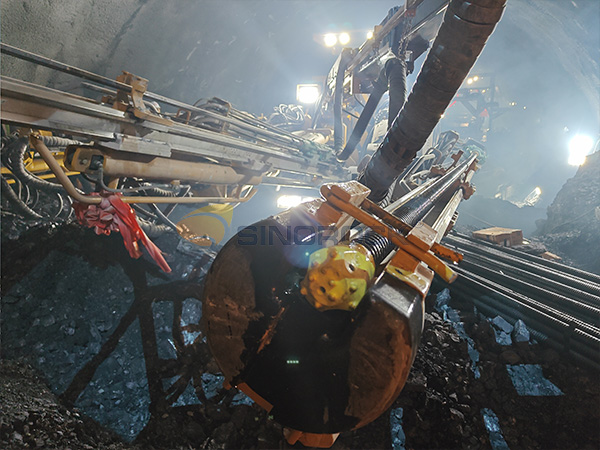
2.3 Soft to Medium-Hard Rock
Examples: Shale, mudstone, moderately weathered sandstone.
Challenges: Medium strength and abrasiveness; risk of bit wear.
Recommended: Cross Carbide Bit.
Why: Provides a balance between rock-breaking performance and cost-efficiency. Carbide inserts fracture rock efficiently while keeping tool replacement costs manageable. Widely used in tunneling and slope stabilization.
2.4 Hard to Extremely Hard Rock
Examples: Granite, basalt, unweathered limestone.
Challenges: High strength, extreme abrasiveness; slow penetration; severe tool wear.
Recommended: Carbide Button Bit or Concave Center Button Bit.
Why: Optimized for impact crushing; concave center improves cuttings removal. Enhances penetration rates and tool longevity. Often combined with high-performance drilling rigs to maximize efficiency.
2.5 Composite Strata
Examples: Interbedded soft–hard formations.
Challenges: Variable conditions; one bit must handle diverse layers.
Recommended: Cross Carbide Bit or Carbide Button Bit if hard rock dominates.
Why: Cross Carbide Bits offer adaptability; button bits excel where hard rock is dominant. Conservative drilling parameters through softer layers protect the bit from excessive wear.
3. Other Key Selection Factors

Drill Rig Capability
Top-head drive rigs pair well with button bits for impact drilling. Rotary rigs are more compatible with cross or clay bits.
Rock Bolt Diameter
The bit must match rock bolt diameter to ensure proper grout coverage and structural integrity.
Grout Type & Pressure
Flushing ports must be large enough to prevent clogging during grouting. Consider grout viscosity and pumping pressure when selecting a bit.
Project Economics
Balance initial bit cost with service life. Evaluate cost per meter/foot drilled and consider downtime, maintenance, and replacement costs.
Safety and Operational Efficiency
A correctly selected bit reduces drilling-induced vibrations, prevents borehole collapse, and minimizes risks to personnel. Efficient bits lower energy consumption and shorten project timelines.
Conclusion
Selecting the right SDA drill bit is a critical decision influencing drilling efficiency, bit longevity, grout delivery, and overall project stability. Understanding bit performance in different soils and rock formations allows engineers to match tools to ground behavior rather than rely on trial and error. Whether the project involves soft soils, loose or fractured ground, or extremely hard formations, proper bit selection reduces risk, improves penetration rates, enhances safety, and supports predictable outcomes in modern geotechnical and tunneling projects.
latest news
-

- Selecting the Right Self-Drilling Anchor Bolt Drill Bit for Different Ground Conditions
- Time:2025-11-26From:This Site
- Learn how to select the right self-drilling anchor (SDA) bolt drill bit for soft soil, loose ground, and hard rock formations. A complete guide to bit types, applications, and performance.
- View details
-
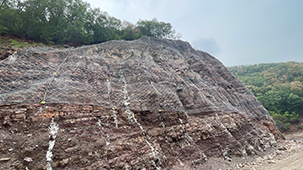
- Application of Self-Drilling Anchor Bolts in Catastrophic Slope Stabilization
- Time:2025-11-19From:This Site
- Learn how self-drilling anchor bolts provide rapid, effective solutions for catastrophic slope stabilization in landslides, rockfalls, and emergency scenarios.
- View details
-
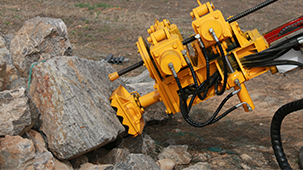
- How Self-Drilling Anchor Bolts Drill and Grout Simultaneously
- Time:2025-11-17From:This Site
- Discover how self-drilling anchor bolts drill and grout simultaneously, improving efficiency, stability, and safety in geotechnical projects. Learn the mechanism, installation process, advantages, and common applications.
- View details
-
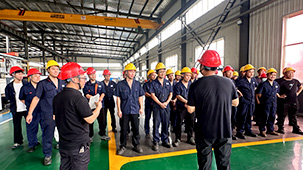
- Sinorock 2025 Quality Month | Strengthening Quality Foundations, Empowering Product Excellence
- Time:2025-08-13From:This Site
- Sinorock’s 2025 Quality Month, themed “Strengthening Quality Foundations, Empowering Product Excellence,” successfully concluded, reinforcing our commitment to superior product quality.
- View details
-
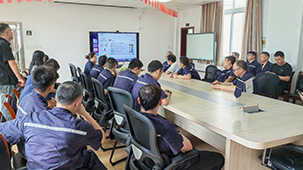
- Sinorock Safety Month 2025 | Everyone Speaks Safety, Everyone Can Respond
- Time:2025-07-03From:This Site
- Sinorock Safety Month 2025, centered on the theme "Everyone Speaks Safety, Everyone Can Respond - Spot Workplace Hazards," has wrapped up successfully!
- View details
-
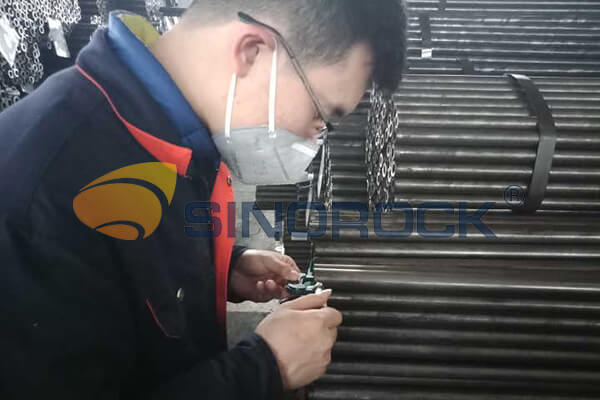
- Quality Control: the Vital Factor of A SDA Bolt Factory
- Time:2025-01-09From:This Site
- Sinorock’s comprehensive quality control system, from supplier management to outgoing inspections, ensuring the highest standards for self-drilling anchor bolts in construction.
- View details
-

- SINOROCK to Showcase Innovative Mining Solutions at Mining and Metals Central Asia 2025
- Time:2025-09-09From:This Site
- We are pleased to share that SINOROCK will participate in the Mining and Metals Central Asia 2025, taking place from September 17 to 19 at the Atakent International Exhibition Centre in Almaty, Kazakhstan. You can find us at Booth 11-231.
- View details
-

- Sinorock Invites You to Explore Proven Self-Drilling Anchor Bolt Solutions at bauma 2025
- Time:2025-03-07From:This Site
- From April 7–13, 2025, explore Sinorock’s Self-drilling anchor bolt solution at Booth C2.513/4 in Hall C2 of the Messe München Exhibition Center (Munich, Germany).
- View details
-
.jpg)
- SINOROCK to Attend EXPOMINA PERÚ 2024 in Lima, Peru
- Time:2024-08-10From:This Site
- Sinorock to Attend EXPOMINA PERÚ 2024 in Lima, Peru
- View details
 Download
Download 


